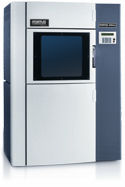Latest News
July 12, 2012
By Anthony J. Lockwood
Dear Desktop Engineering Reader:
 Often when I visit a high-tech company, I’m asked about what kind of person you are. I respond by pulling a click-top pen out of my pocket. While slowly disassembling the pen, I say that the DE readers are engineers like themselves. I say that the DE reader is the person who sees that pen and wonders if it has a mechanism they never investigated or how it was made. And should I hand it over to them, they’ll take the pen apart, and maybe check the spring tension. Their DNA demands discovery. We chuckle in recognition of that person. I put the pen on the table. Yet before the meeting is over, one of the engineers will pick it up and inspect it.
Often when I visit a high-tech company, I’m asked about what kind of person you are. I respond by pulling a click-top pen out of my pocket. While slowly disassembling the pen, I say that the DE readers are engineers like themselves. I say that the DE reader is the person who sees that pen and wonders if it has a mechanism they never investigated or how it was made. And should I hand it over to them, they’ll take the pen apart, and maybe check the spring tension. Their DNA demands discovery. We chuckle in recognition of that person. I put the pen on the table. Yet before the meeting is over, one of the engineers will pick it up and inspect it.
There’s a funny thing about that trait though. We use all sorts of technologies but never get around to looking into them until one fine day when that gotta know gene kicks in. Today’s Check It Out write-up might just fall into that category.
Since the mid-90s, the techno-press people have been talking about Stratasys and its Fused Deposition Modeling (FDM) technology. We’ve seen the company grow up from the Genisys rapid prototyping system to today’s desktop-sized professional-level Mojo, personal uPrint, mid-range Dimensions, and production-class Fortus line of systems.
Fortus is interesting, by the way. It’s really a “what do you want to do” manufacturing system that you can build a business around. It can handle printing out concept models, functional prototypes, end-use parts, and even tooling fixtures. It builds parts out of all sorts of thermoplastic materials, including ABS, a translucent ABS, some polycarbonates, and some poly-plastics. Outfits designing and making everyday consumer products, medical devices, and so on deploy Fortus. Schools use it too. Check out the video here to see how Boeing uses it.
But I digress. The point here today is how does FDM technology in, say, a Fortus system really work? And, no, saying it’s an additive manufacturing process does not answer the question entirely. The answer to the question is what today’s Check It Out quick read document is all about.
“3D Printing with FDM: How it Works” takes you for a look at what’s going on inside of a Fortus system and the process of getting a part from CAD to real life made. It covers the software to prep a file, and it explains the major system components and the jobs they preform. It leads you through the creation, building, and post-processing stages of fabricating a 3D part. Now, there’s nothing terribly deep here in terms of theory, physics involved, etc. Still, “3D Printing with FDM: How it Works” is a tasty snack for the engineer’s inquisitive mind nonetheless.
The upshot is that this is a quick, fun, and informative read. Hit the link over there and see for yourself. Go ahead, I know you can’t help yourself. You just have to know a little something about how FDM works.
Thanks, Pal.—Lockwood
Anthony J. Lockwood
Editor at Large, Desktop Engineering
Subscribe to our FREE magazine, FREE email newsletters or both!
Latest News
About the Author
Anthony J. Lockwood is Digital Engineering’s founding editor. He is now retired. Contact him via [email protected].
Follow DE





